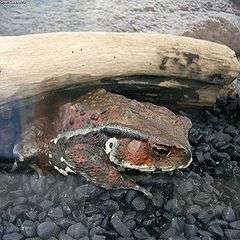Japanese common toad
| Japanese common toad | |
|---|---|
 | |
| Scientific classification | |
| Kingdom: | Animalia |
| Phylum: | Chordata |
| Class: | Amphibia |
| Order: | Anura |
| Family: | Bufonidae |
| Genus: | Bufo |
| Species: | B. japonicus |
| Binomial name | |
| Bufo japonicus Temminck & Schlegel, 1838 | |
The Japanese common toad or Japanese toad (Bufo japonicus) is a species of toad in the family Bufonidae. It is endemic to Japan. Its natural habitats are subarctic forests, temperate forests, temperate shrubland, swamps, freshwater marshes, intermittent freshwater marshes, freshwater springs, arable land, rural gardens, urban areas, ponds, and irrigated land.
Description
The Japanese common toad develops a snout-to-vent length of about 17 cm (7 in), with females being a little larger than males, and toads living in warmer habitats growing larger than those in colder places. The head has a pointed snout and is roughly triangular. The tympanum is elliptical and about as far behind the eye as its longest diameter. The body is robust and the stout forelimbs are about half as long as the hind limbs. The second finger on the hand is the shortest and the third the longest. On the hind foot, the first toe is the shortest and the fourth the longest. There is little webbing between the toes. The skin has small warty outgrowths and its colouring is variable, being greenish-brown, yellowish-brown or darker brown. It is often paler and smoother in the breeding season.[2]
Distribution
The Japanese common toad is native to Japan and is present on the islands of Honshu, Hokkaido, Kyushu and Shikoku and has been introduced to the island of Izu Ōshima. It is present in a wide variety of types of habitats including in lowland and mountainous areas.[1]
Biology
.webm.jpg)
The Japanese common toad lives mainly on land, feeding on earthworms and small arthropods including ants and some species of beetle that are lamentable to other predators.[2] It hibernates underground in the winter when the temperature falls below about 6 °C (43 °F). Breeding takes place in the spring when the toads congregate in shallow water bodies and long strings of eggs are laid and become tangled in underwater plants. The dark-coloured tadpoles grow to 30 or 40 millimetres (1.2 or 1.6 in) in length before emerging from the pond as juvenile toads in June.[2]
Status
The Japanese common toad has a wide range and is tolerant of many different types of habitats including man-made ones. It is presumed to have a large total population and no significant decline in numbers has been observed so the International Union for Conservation of Nature has assessed its conservation status as being of "least concern".[1]
References
| Wikimedia Commons has media related to Bufo japonicus. |
- 1 2 3 Yoshio Kaneko; Masafumi Matsui (2004). "Bufo japonicus". IUCN Red List of Threatened Species. Version 2013.2. International Union for Conservation of Nature. Retrieved 2014-09-20.
- 1 2 3 Asako Miyakawa (2004-10-05). "Bufo japonicus". AmphibiaWeb. Retrieved 2014-09-19.
